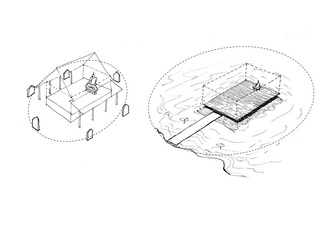The Status of Academic Output in the Isan Water Sim (Northeastern Buddhist Ordination Hall) in the Northeastern Region of Thailand
Main Article Content
Abstract
This study collected directly related academic materials studied from 1987 – 2019 A.D., from books, research papers, academic articles and case study in field work surveys then analyzed and synthesized the contexts of water Sim (ordinary hall) apart from architectural forms.
It was found that water Sim was used for Buddhist rituals, especially ordination ceremony, with water as the boundary. Water Sim has not only been found in the Northeast of Thailand, but also in the North, and in Lao PDR, where temporary rafts and buildings on water were also found. For the Northeast of Thailand, it was found that 1) water was the main aspect for design concept which portrayed purity and holiness; however, land Sim has already replaced water Sim; 2) the location of Sim was based on Buddhist disciplines and geographical aspects in the Northeast of Thailand, where plateaus and small hills were generally found; and 3) the design can be categorized into 3.1 temporary raft, constructed in remote areas when land Sim was not yet ready for permanent construction; and 3.2 Sim in the pond or swamp, comprising 1.) the wooden one used for ordination ceremony and later removed; 2.) the wooden one for permanent use; and 3.) the concrete one which has still been in use. In the beginning, water Sim was constructed for Buddhism rituals, especially ordination ceremony; however, after 1957 A.D., water Sim was abandoned and replaced by permanent land Sim, this was accepted by the Mahanikaya group, while water Sim was still preferred by Dhammayuttikanikaya group.
It was also found that water Sim was simple and compatible with the natural landscapes, surroundings, plantation and water resources as well as how the monks of Dhammayuttikanikaya should behave. The value of water Sim should be considered a holistic approach, not only architectural features which should be focused, but also geographical environment, concepts and design.
Downloads
Article Details

This work is licensed under a Creative Commons Attribution-NonCommercial-NoDerivatives 4.0 International License.
References
Amarit Muadthong. Rāingān wičhai chabap sombūn Si mō̜nam (ʻubōsot bon nam) sathāpattayakam thāng phut sātsanā ʻĪsān [Water Sim: Northeast Buddhist Water Holy Temples, Final Report]. Mahasarakham: Faculty of Architecture, Urban Planning and Creative Arts, 2012.
ʻAnusō̜n ngān sop Phra ʻā čhāfan ʻāčhān thēra [The Cremation Memorial Book of Pra Ajahn Fun Achatara]. Bangkok: Chuan Pim Press, 1978.
Khensingha Rongchai and Phisada Jamphon. Prawat Thai bān khamwā [History of Khamwha villager].
Lūang Pū Bun pheng Kap pakō thīralư̄k nai kān phrarātchathān phlœ̄ng sarīra sangkhān Phra Sōphon wi sutthi khun (Lūang pū Bun pheng Kap pakō) Wat Pā Wiwēk Tham čhangwat Khō̜n Kǣn [Luang Pu Boonpheng Kappago : the Cremation Memorial Book of Phra Sophowisuthikhun, Wat Pa Wivekdham, Khon Kaen Province]. Khon Kaen: Khon Kaen Printing Partnership Limited, 2017.
Pattara Maitrarat and Songyot Weerataweemat. “Khwām song čham tō̜ phra pā sāi Lūang Pū Man yuk bukbœ̄k [The Remembrance of Luang Pu Man Bhuridhatta’s Lineage Forest Monks in Initial Stage].” 234-251. in Conference Proceedings of The 13th Thai Humanities Research Forum, New Regionalism and Localismin the Borderless World.” Mahasarakham, Thailand. September 6-7, 2019.
Phrakhru Prayoot Khantidhamma, Abbot of Wat Pa Kut Wah. Interview, November 5, 2022.
Sumet Jumsai na Ayudhya. Nam: bō̜kœ̄t hǣng watthanatham Thai [Water: The Origin of Thai Culture]. 2nd ed. Bangkok: The Association of Siamese Architects under Royal Patronage, 1996.
Suwit Jiramanee. Sinlapa sathāpattayakam phư̄ n thin ʻĪsān nai watthanatham Thai - Lāo . [Isan Vernacular Architecture in Thai-Lao Culture]. Chon Buri: Faculty of Fine and Applied Arts, Burapha University, 2002.
Suwit Theerasawat. Prawattisāt ʻĪsān sō̜ngphansāmrō̜iyīsipsō̜ng thưng sō̜ngphansīrō̜ipǣtsippǣt lem nưng [Isan History 1779-1945, Volume 1]. Khon Kaen: Faculty of Humanities and Social Sciences, Khon Kaen University, 2014.
Thapakon Kruaraya. “‘Uthok sīmā wiwatthanākān phǣ khanān sū ‘ubōsot klāng nam nai watthanatham Lānnā [Udakukkhepa Sima: Evolution of a Raft to an Ordination Halls in the Pond of Lanna Culture].” NAJUA: Architecture, Design and Built Environment 32 (January-December 2017): A29-A50.
Theerapong Meethaisong. “Phra song kap ‘ong čhao nai kanpatirūp hūamư̄ang ‘Īsān phān konkai ‘amnāt rat [Monks and King in the Reformation Isan Through State Apparatus].” Humanities & Social Sciences 34, 3 (September-December 2017): 288-309.
Wachirayan Warorot, Prince-Patriarch. Winai muk lem sām [Main Principles of the Discipline, Volume 3]. 26th ed. Bangkok: Mahamakut Buddhist University Press, 2010.
Wiroj Srisuro. Si mō̜ ʻī sān [Isan Sim Northeast Buddhist Holy Temples]. Bangkok: Meka Press Public Company Limited, 1993.


